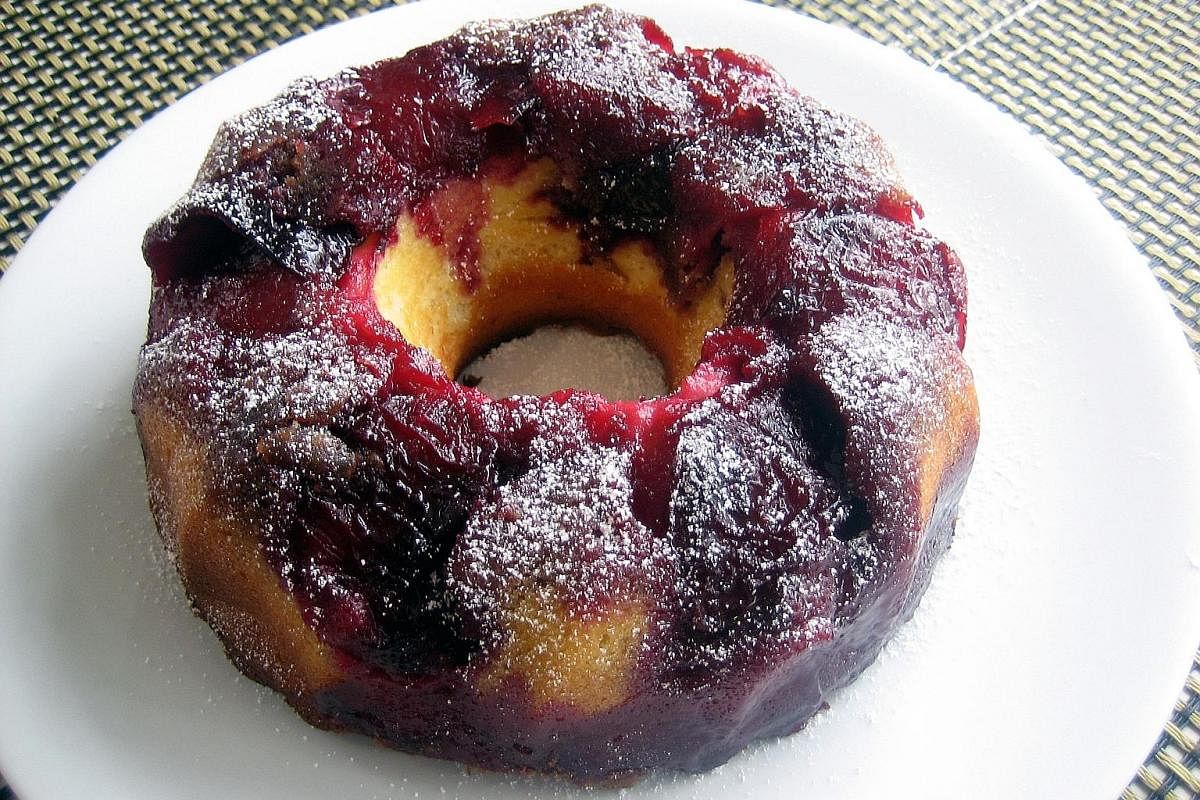-
UPSIDE-DOWN PLUM CAKE
-

-
INGREDIENTS
190g butter60g brown sugar
6 to 7 red or yellow plums (about 650g), halved and with stones removed
180g caster sugar
3 eggs
200g plain flour, sifted together with 11/2 tsp baking powder
50g almond meal
4 tbsp buttermilk or milk
Vanilla ice cream (optional)
Method:
1. Preheat the oven to 180 deg C.2. Grease a bundt pan or 22cm-diameter round cake pan.
3. Melt 40g of the butter and drizzle it over the base of the pan. Sprinkle the brown sugar over the melted butter.
4. Place the plums, skin side down, on top of the melted butter and brown sugar (pictured).
5. Beat the remaining butter with the caster sugar until pale and creamy.
6. Add the eggs, one at a time, while continuing to beat the mixture. If it starts to curdle, add a tablespoon of the sifted flour.
7. Fold in the remaining sifted flour, baking powder and almond meal. Gently stir in the buttermilk or milk.
8. Pour the batter into the pan and bake for about 45 minutes, or until a skewer inserted into the cake comes out clean. Let the cake sit in the pan for about 10 minutes before serving, either plain or with a scoop of vanilla ice cream.
Serves eight
Hunger Management
Reliving childhood with a cake
Climbing trees to pick fruit for my mother had its rewards in bakes such as upside-down cakes

Today's recipe has its roots in my childhood, growing up on a farm in New Zealand.
As well as a host of different animals, we had an orchard. Looking back now, I realise how much we took that orchard - where we could pluck almost any fruit we wished all year round - for granted.
It was big, a bit tangled and disorganised. Many trees had been there for decades and some were so tall that it was a challenge to pick their fruit.
But that was one of its charms. Because much of the fruit was out of reach from the ground, my sister and I had great fun climbing the trees, either to pick fruit for our mother to prepare and preserve, or simply to get that great-looking peach, apple or plum as a snack for ourselves.
The art of preserving fruit in large jars at home has been driven out of fashion by the availability of factorymade canned fruit. But for anyone lucky enough to have access to a fruit tree, home preserving is a great way to save money and a satisfying task.
Armed with nostalgic memories, I decided, on my almost daily supermarket trawl, to make something using plums for this column: a fruit upside-down cake, so called because the fruit is baked in the bottom of the baking pan, with the cake mixture on top. Once baked and turned upside down, the juicy fruit becomes the topping.
Besides plums, other stone fruit, such as nectarines, peaches and apricots, would be suitable. Berries and pineapple slices are also good.
Try adding some blueberries or cut strawberries among the stone fruit for more colour and a more decorative look. Frozen berries would work as well - there is no need to defrost them before use.
Despite the abundance of fruit in our orchard, I recall that one of my mother's favourite versions of the upside-down cake was to use rings of canned pineapple as the base, with a red cherry in the centre of each pineapple ring. It always looked festive.
I find that most fruits have an affinity with baking. They are great baked inside a cake (banana cake, for example), as a topping (like in today's recipe) or as part of a baked dessert (such as an apple or peach crumble).
One small hint when it comes to choosing the baking pan for an upside-down cake - it is best to use one with a solid bottom. Avoid springform pans with a removable base. I learnt, to my peril, after having to clean sticky fruit juice from the bottom of my oven, that it will leak from a loose-bottomed pan.
In fact, I prefer to use a bundt pan, which is a round pan with fluted or grooved sides and a central tube which will produce a cylindrical hole in the middle of the cake. This design means that more of the mixture touches the surface of the pan than in the usual round cake tin, allowing more even heat distribution during baking.
And of course, the cake itself will have a more interesting shape. You can also add more flavour by filling the hole in the middle of the cake with other fruit.
Join ST's Telegram channel and get the latest breaking news delivered to you.
A version of this article appeared in the print edition of The Sunday Times on April 23, 2017, with the headline Reliving childhood with a cake. Subscribe
